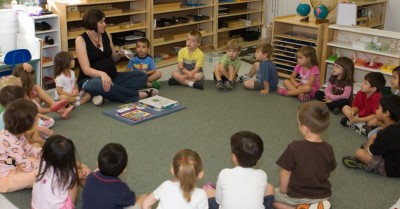Circle times go beyond just sharing a book or singing songs. Children get the chance to acquire new ideas and concepts, participate in group learning experiences, communicate and work together during circle time. However, sometimes there are barriers to overcome - a child may not want to join, a child who runs away, a child who distracts others, or a child bored. The following article provides strategies on what to do when children struggle with circle time.
Common Barriers To Circle Time Participation
- Becoming preoccupied with nearby peers who are other peers.
- Losing focus/interest quickly during circle time exercises.
- Having trouble with children being too close to (tactile hypersensitivity).
- Improperly seeking out sensory information (e.g. fidgeting, rocking, leaning, falling on the floor, standing up, wandering).
- Having trouble putting up with the music and voices of peers during circle time (auditory hypersensitivity).
- Having trouble staying in one place for a prolonged amount of time.
Strategies To Support Children Who Struggle With Circle Time
- Try calming techniques to help children make a smooth transition to circle time.
- Use timers to count down to the transition and let kids bring a transition object or toy with them to circle time to deposit in a designated place. Use visual schedules here too.
- Leaving children hanging while you get your supplies and songs organized and prepared is a sure way to kill the momentum of your circle time. Have these things ready ahead of time to eliminate waiting time.
- Sometimes giving children something to do with their hands can help lengthen their attention span for circle time. Try basic activities like stringing beads.
- If a child struggles to remain attentive during circle time, place them at a different table or desk close to the circle time area and have her finish one of the aforementioned chores (while circle time is in progress) before allowing them to leave the environment and play elsewhere. Increase the time spent participating in the activities at the desk gradually until the kid spends the majority of circle time seated.
- Fidget toys provide children with something to do with their hands as they listen and participate in circle time, much like the fine motor exercises mentioned above. Try fidget toys that can attach to the student's belt loop or zipper if they have a tendency to chuck things.
- During circle time, additional seating may be utilised. Different seating options can help kids who struggle with maintaining personal space or with having peers near to them by offering support for kids who have weaker core muscles, a little movement for kids who need to wriggle and squirm, or a barrier.
- Negative behaviours can be minimised by maintaining a pattern during circle time that is reasonably constant. Children are frequently calmer and more ready to engage when they are aware of what will happen next and how long an activity will last. For children with sensory issues, this level of regularity might be especially beneficial.
- Incorporate as much movement as you can during circle time. Fidgeting and other behaviours can be reduced by using movement songs, movement breaks, and learning activities that let youngsters get up and move. Even really brief, extremely basic movement breaks (e.g., everyone claps your hands as quickly as you can! Everyone raises a hand to shake! It can be beneficial for everyone to tap their legs, shoulders, head, etc. between circle time activities.
- Gather tools, items and materials that children can touch and manipulate to extend their understanding of a concept or idea being introduced. For new equipment or activities that have been purchased show the group how to use this properly. Group time should be a hands-on experience.
- Choose books with purpose and meaning. Select books based on the children’s age and understanding. Read through the book beforehand to gain a grasp of what the story is about and how you will get the children to participate in the story. Books can also be chosen based on the group’s interests, concepts or moral development. Also, when a book is chosen it’s a good idea to stick with the same book for the week. It supports children’s understanding, language development, memory and concentration when reading the same book throughout the week.
- Find an item that relates to the story which the children can touch and hold. This will enable children to connect the story and real life.
- Create visual representation during discussions, presenting ideas or new concepts. Use flannel boards, graphs, charts, magnetic boards, computers, poster paper, etc. These should be used to engage the children so they can use to interact with the visual rather than just sit and listen. Actively involve children by writing down their thoughts and ideas (through mind maps, brainstorming etc.) to share with others on topics being discussed during group time
- Take a responsive approach during group time. Base it on the needs and the interests of the children rather than feeling compelled to complete what has been planned. As part of your intentional teaching if you have plans to start a topic but interest begins during the morning go ahead with the interest first and foremost. The more group time is catered for the children, they will be eager to participate and get involved.
- Have a group time routine that the children can get used to. This gives them an understanding of what to expect and when and feel more confident participating in group time. For example: sing a group time song at the beginning, read a story, group discussion/intentional teaching, group game/music and movement, group song and then transition song to the next task.
Further Reading
Group Time With Children In Childcare - The following article provides information on What Is Group Time, What To Do During Group Time, Managing Group Time and more.
Yarning Circles In Early Childhood Services - The following article provides information on Yarning Circles, Objectives Of Yarning Circles, Implementing Yarning Circles and more.
Show and Tell For Preschoolers - The following article provides information on the benefits of show and tell, preparing for the show and tell and more.
Rhymes and Songs - A variety of rhymes and songs that can be sung during group time.
Reference:
Kids and Group Time, Inspired Tree House







 As an Educator in Australia, your pay rate falls under the Children’s Services Award 2010. This award states the minimum amount that an employer can
As an Educator in Australia, your pay rate falls under the Children’s Services Award 2010. This award states the minimum amount that an employer can When working as a qualified Early Childhood Teacher (with a university degree) within a service, your rate of pay will come from the Educational Services
When working as a qualified Early Childhood Teacher (with a university degree) within a service, your rate of pay will come from the Educational Services When working as a Diploma Qualified Educator your pay rate is from the Children's Services Award 2010. This Award states your minimum rate of pay
When working as a Diploma Qualified Educator your pay rate is from the Children's Services Award 2010. This Award states your minimum rate of pay When working as a Cert 3 Qualified Educator, your pay rate is from the Children's Services Award 2010. This Award states your minimum rate of
When working as a Cert 3 Qualified Educator, your pay rate is from the Children's Services Award 2010. This Award states your minimum rate of Educational Leaders play a crucial role in their early childhood service by ensuring that the educational program aligns with best practices and supports the holistic
Educational Leaders play a crucial role in their early childhood service by ensuring that the educational program aligns with best practices and supports the holistic In early childhood education and care, ratios are more than a technicality—they are a frontline safeguard. Every child deserves responsive supervision, emotional connection, and developmental
In early childhood education and care, ratios are more than a technicality—they are a frontline safeguard. Every child deserves responsive supervision, emotional connection, and developmental With the new national child safety reforms kicking in on 1 September 2025, early childhood services like yours have a real opportunity to lead the
With the new national child safety reforms kicking in on 1 September 2025, early childhood services like yours have a real opportunity to lead the Here’s a comprehensive Mobile Phone and Smart Watch Policy tailored for early childhood education and care (ECEC) services in Australia, aligned with the latest 2025
Here’s a comprehensive Mobile Phone and Smart Watch Policy tailored for early childhood education and care (ECEC) services in Australia, aligned with the latest 2025 The Sea of Fish Challenge is a national initiative that invites children, educators, families, and communities to create and display fish artworks as a symbol
The Sea of Fish Challenge is a national initiative that invites children, educators, families, and communities to create and display fish artworks as a symbol Across the early childhood education and care sector, educators are sounding the alarm: current staffing ratios are insufficient to deliver safe, meaningful, and developmentally appropriate
Across the early childhood education and care sector, educators are sounding the alarm: current staffing ratios are insufficient to deliver safe, meaningful, and developmentally appropriate


